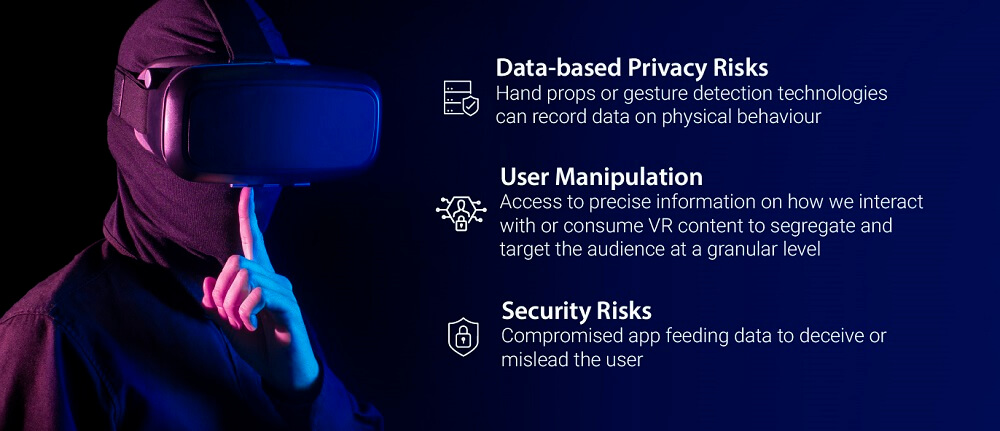VR and AR - Security and Privacy Risks for 2022
Virtual reality is a promising technology, but there are some serious risks when it comes to security.
These new technologies are untrustworthy, which is why we need rock-solid security and privacy measures. It is also important not to share personal information, especially payment information. Even if you are using a trusted website, you could be sharing your credit card number with a fake website.

AR poses the risk of deep fakes, which are artificially created images or videos. Another risk posed by AR and VR technology is a potential denial of service attack, which can cut off the stream of information. This would be particularly concerning for professionals in critical situations. Wearable AR devices may pose physical risks. While some wearables are more resilient than others, they are still susceptible to physical damage. For example, a surgeon using AR glasses might lose access to real-time information. Similarly, a driver wearing an AR windshield may not be able to see well if a car accident takes place - causing the driver to lose sight of the road.
In addition to physical harms, VR and AR could also lead to privacy issues. The invasive nature of the technology can lead to identity theft, which can affect employers, insurers, and others. Children are also at risk of being tracked. Children are at a particularly high risk of being a victim of identity theft. Many of these children are not old enough to understand how their personal information is being used, and may be monitored by the wrong people. They may be deprived of their privacy by VR or AR technology, and their consent is not fully developed. Therefore, security and privacy risks related to the technology should be addressed at an early stage. Researchers and activists must work to create a future in which AR and VR are safe for users and society. Developers and reviewers should prioritize privacy-conscious devices over a wide range of applications.

A recent report by the Federal Trade Commission cited the privacy risks associated with virtual reality and augmented reality. While AR offers exciting possibilities for user experiences and research, the use of this technology must be mindful of the security and privacy risks associated with it. Additionally, the potential for cybercriminals to gain access to personal information will increase as well, as multiple unrelated aspects of these technologies will create a ripe environment for hackers and other malicious actors. Similarly, the lack of warnings and security tools will make users more susceptible to ransomware attacks.
While most companies and organizations do not collect location-based data for illegal activities, some experiences and applications depend on geo-location information. The data that these devices collect is not protected by existing laws, and it is important to ensure that the privacy of those using them is protected in this manner. A major concern is the misuse of VR and AR data by third parties. Because of this, it is important to consider how AR and VR technologies will impact our society and our rights as individuals.
Identity theft and data misuse are significant concerns when VR is used in public spaces. While privacy laws may limit AR/AR technology's development, privacy laws still need to be amended. Congress should also pass laws to address privacy issues. There are new types of data collection, including biometric information and inferred personal information. Federal legislation is necessary to ensure that compliance requirements are consistent. For example, in some cases, companies can use biometric data to create a person's identity.

In the future, companies could collect more personal information. However, the data collected would be used for advertising purposes. As the use of VR continues to expand, data providers will need to provide more value-added services and APIs.
While the benefits of VR and AR are undeniably exciting, the risks also present several important considerations. Because of the nature of the technology, users should keep their information private. Further, the risks include identity theft, harm to reputation, and decreased privacy. If the user cannot even consent to the risk, the information can be misused and sold.
Moreover, the data generated by these technologies is more than just an entertainment medium. The threat of deepfakes is a security risk, and deepfakes can manipulate recorded images and videos. The technology can be manipulated in such a way that the user's identity is compromised. The use of digital overlays could also be a cause of a crisis. These risks are exacerbated by the fact that many users are unaware of the risks.
The security and privacy risks of these technologies must be assessed and carefully managed by law enforcement authorities. These devices are capable of displaying a person's image on the lenses. They could be made to look like real people, and the potential risks of identity theft are significant. In order to protect their users, developers and consumers must implement new technologies that protect their data and privacy.
In addition to these risks, organizations should be aware of the opportunities that AR affords. There are already a number of security issues related to the technology, and organizations should be aware of the potential for these issues.
Some of the most risks serious are related to biometric data. These technologies collect information about the user's movements and their behavior. Moreover, they contain biometric information. As a result, malicious actors can replicate the biometric information of the user to steal identities. Further, the data collected from a user's virtual world can be used by attackers to spy on the person.
BACK TO NEWS